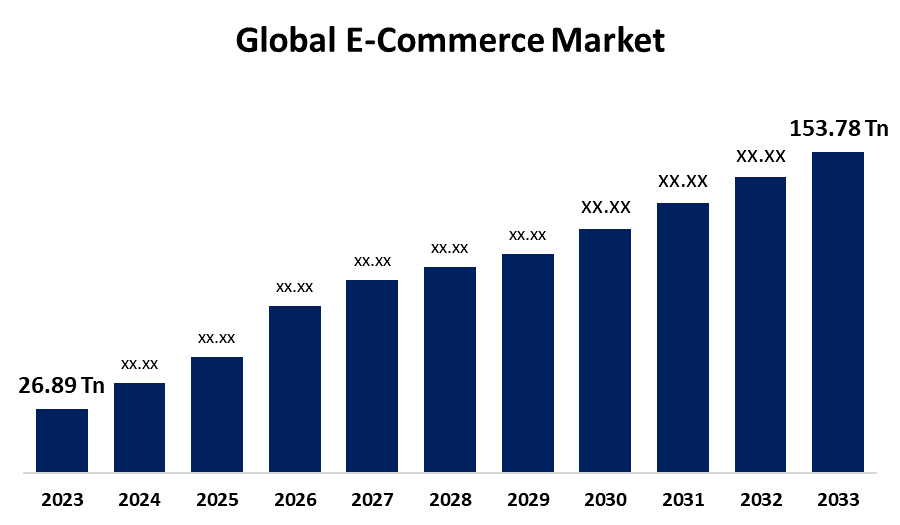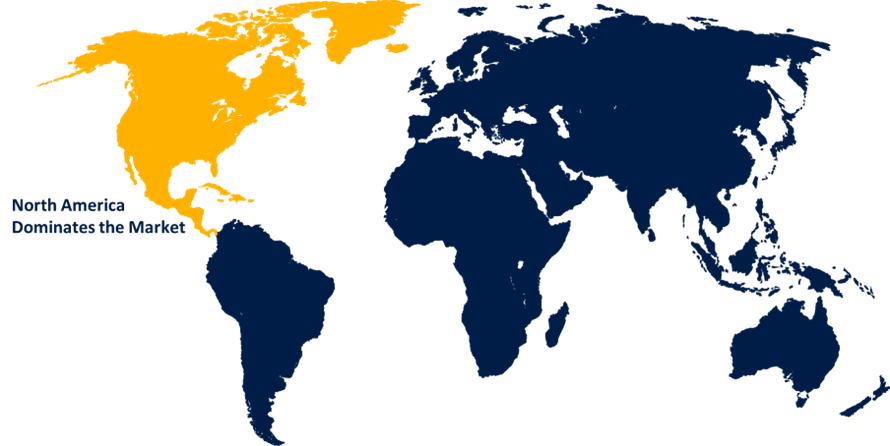Global E-Commerce Market Size, Share, and COVID-19 Impact Analysis, By Product (Automotive, Beauty & Personal Care, Books & Stationery, and Consumer Electronics), By Model Type (Business-to-Business, Business-to-Consumer, and Consumer-to-Consumer), and By Region (North America, Europe, Asia-Pacific, Latin America, Middle East, and Africa), Analysis and Forecast 2023 - 2033.
Industry: Information & TechnologyGlobal E-Commerce Market Insights Forecasts to 2033
- The Global E-Commerce Market Size Was Estimated at USD 26.89 Trillion in 2023
- The Market Size is Expected to Grow at a CAGR of around 19.05% from 2023 to 2033
- The Worldwide E-Commerce Market Size is Expected to Reach USD 153.78 Trillion By 2033
- Europe is Expected to Grow the fastest during the forecast period.

Get more details on this report -
The Global E-Commerce Market size was worth around USD 26.89 Trillion in 2023 and is predicted to Grow to around USD 153.78 Trillion By 2033 with a compound annual Growth rate (CAGR) of 19.05% between 2023 and 2033. The digital marketplace is becoming more and more popular among customers because of time restrictions, the requirement for a seamless shopping experience, and the convenience of online purchasing. Particularly with the growing popularity of smartphones and tablets, mobile technology has been crucial in enabling customers to make purchases easily from any location.
Market Overview
The worldwide online purchasing and selling of products and services using digital platforms is referred to as the global e-commerce market. It covers a range of business formats, including direct-to-consumer (D2C), business-to-business (B2B), consumer-to-consumer (C2C), and business-to-consumer (B2C). Growing internet usage, mobile commerce, digital payments, and changing customer preferences are some of the reasons propelling this industry. Among the leading companies are Flipkart, Alibaba, eBay, Amazon, and Shopify. The market includes sectors such as digital services, fashion, electronics, retail, and food. The advancement of secure payment gateways and encryption technology has boosted consumer confidence and encouraged online transactions. Online buying has been significantly impacted by the growth of social networking sites. Because it enables businesses to engage with their target audience, showcase their products, and boost traffic to their e-commerce websites, social media is a powerful marketing tool. Furthermore, there are several different sectors within the global e-commerce market. Fashion, electronics, and groceries are all included in the retail sector, which is expected to reach a market size of $4.32 trillion by 2025. Digital procurement is driving the rapid growth of B2B e-commerce. As more people have access to the internet, digital services like streaming and online learning are growing. Online reservations are crucial to the travel and hospitality industries.
Report Coverage
This research report categorizes the e-commerce market based on various segments and regions forecasts revenue growth, and analyzes trends in each submarket. The report analyses the key growth drivers, opportunities, and challenges influencing the e-commerce market. Recent market developments and competitive strategies such as expansion, type launch, development, partnership, merger, and acquisition have been included to draw the competitive landscape in the market. The report strategically identifies and profiles the key market players and analyses their core competencies in each sub-segment of the e-commerce market.
Global E-Commerce Market Report Coverage
| Report Coverage | Details |
|---|---|
| Base Year: | 2023 |
| Market Size in 2023: | USD 26.89 Trillion |
| Forecast Period: | 2023-2033 |
| Forecast Period CAGR 2023-2033 : | 19.05% |
| 2033 Value Projection: | USD 153.78 Trillion |
| Historical Data for: | 2019-2022 |
| No. of Pages: | 255 |
| Tables, Charts & Figures: | 128 |
| Segments covered: | By Product, By Model Type, By Region |
| Companies covered:: | Flipkart.com, JD.com, Lazada, MercadoLibre S.R.L., Shopify, ASOS, Costco Wholesale Corporation, Dangdang, eBay Inc., Walmart, and other key vendors. |
| Pitfalls & Challenges: | COVID-19 Empact, Challenge, Future, Growth, & Analysis |
Get more details on this report -
Driving Factors
A major driver of the e-commerce technology business is the rise in e-commerce sales. Due to a number of causes, including the growing number of tech-savvy people, the expanding use of smartphones, and the growing Internet penetration, the e-commerce industry is developing rapidly. The desire for goods made abroad is also driving growth by resulting in sales through cross-border e-commerce. Additionally, the availability of numerous payment methods, including cash-on-delivery (COD), credit and debit cards, Internet banking, and electronic wallets, has caused a paradigm change in consumer behavior away from physical businesses and toward online buying.
Restraining Factors
One of the biggest obstacles facing the e-commerce technology market throughout the projection period will be the growing worries about data security and privacy. The main obstacles to the uptake of e-commerce technologies are data privacy and security threats. Hackers are always seeking to find weaknesses and gaps in the architecture of e-commerce.
Market Segmentation
The e-commerce market share is classified into product and model type.
- The consumer electronics segment accounted for the highest share in 2023 and is projected to grow at a substantial CAGR during the forecast period.
Based on the product, the e-commerce market is divided into automotive, beauty & personal care, books & stationery, and consumer electronics. Among these, the consumer electronics segment accounted for the highest share in 2023 and is projected to grow at a substantial CAGR during the forecast period. The growth can be attributed to increasing integration of consumer electronics with smooth interaction opportunities, which is a major motivator. In order to improve the user experience overall, 5G technology is being used by smartphones, smartwatches, tablets, and other devices to deliver faster internet speeds, reduced latency, and improved connectivity.
- The business-to-business segment accounted for the majority share in 2023 and is anticipated to grow at a remarkable CAGR during the forecast period.
Based on the model type, the e-commerce market is divided into business-to-business, business-to-consumer, and consumer-to-consumer. Among these, the business-to-business segment accounted for the majority share in 2023 and is anticipated to grow at a remarkable CAGR during the forecast period. ERP software and customer relationship management (CRM) systems are two examples of how the dominance of B2B e-commerce platforms is increasingly integrating with other company tools and systems. By simplifying processes, the connection raises the general effectiveness of B2B transactions. E-commerce platforms facilitate cross-border trade by enabling businesses to purchase goods and services from foreign suppliers.
Regional Segment Analysis of the Global E-Commerce Market
- North America (U.S., Canada, Mexico)
- Europe (Germany, France, U.K., Italy, Spain, Rest of Europe)
- Asia-Pacific (China, Japan, India, Rest of APAC)
- South America (Brazil and the Rest of South America)
- The Middle East and Africa (UAE, South Africa, Rest of MEA)
North America is anticipated to hold the largest share of the e-commerce market over the predicted timeframe.

Get more details on this report -
North America is anticipated to hold the largest share of the e-commerce market over the predicted timeframe. The booming bakery industry and a significant consumer base with an active interest in customized and designer cakes contribute to the region's growth in the market for premium fondant products, thus expanding regional progress during the forecasting period. Most of the adults in the region directly buy fondant from manufacturers for use in the making of various custom shapes during birthday parties, wedding anniversaries, and other celebrations.
Europe is expected to grow at a rapid CAGR in the e-commerce market during the forecast period. The European B2C industry is expanding as a result of consumers' changing desires for flexibility and convenience, which are encouraging them to think about shopping online. E-commerce platforms' accessibility and ease of use have completely changed how people buy consumer electronics, apparel, shoes, cosmetics, and personal care items.
Competitive Analysis:
The report offers the appropriate analysis of the key organizations/companies involved within the e-commerce market along with a comparative evaluation primarily based on their type of offering, business overviews, geographic presence, enterprise strategies, segment market share, and SWOT analysis. The report also provides an elaborative analysis focusing on the current news and developments of the companies, which includes type development, innovations, joint ventures, partnerships, mergers & acquisitions, strategic alliances, and others. This allows for the evaluation of the overall competition within the market.
List of Key Companies
- Flipkart.com
- JD.com
- Lazada
- MercadoLibre S.R.L.
- Shopify
- ASOS
- Costco Wholesale Corporation
- Dangdang
- eBay Inc.
- Walmart
- Other.
Key Target Audience
- Market Players
- Investors
- End-users
- Government Authorities
- Consulting And Research Firm
- Venture capitalists
- Value-Added Resellers (VARs)
Recent Development
- In November 2023, A Memorandum of Understanding (MoU) was signed by Amazon.com, Inc. and West Bengal Industrial Development Corporation (WBIDC) to boost West Bengal's exports. Through this partnership, the emphasis will be on using Amazon.com, Inc.'s platform to promote and expedite West Bengal companies' exports of goods.
Market Segment
This study forecasts revenue at global, regional, and country levels from 2023 to 2033. Spherical Insights has segmented the e - commerce market based on the below-mentioned segments:
Global E-Commerce Market, By Product
- Automotive
- Beauty & Personal Care
- Books & Stationery
- Consumer Electronics
Global E-Commerce Market, By Model Type
- Business-to-Business
- Business-to-Consumer
- Consumer-to-Consumer
Global E-Commerce Market, By Regional Analysis
- North America
- US
- Canada
- Mexico
- Europe
- Germany
- UK
- France
- Italy
- Spain
- Russia
- Rest of Europe
- Asia Pacific
- China
- Japan
- India
- South Korea
- Australia
- Rest of Asia Pacific
- South America
- Brazil
- Argentina
- Rest of South America
- Middle East & Africa
- UAE
- Saudi Arabia
- Qatar
- South Africa
- Rest of the Middle East & Africa
Frequently Asked Questions (FAQ)
-
1. What is the CAGR of the e-commerce market over the forecast period?The Global E-Commerce Market is projected to expand at a CAGR of 19.05% during the forecast period.
-
2. What is the market size of the e-commerce market?The Global E-Commerce Market size is expected to grow from USD 26.89 trillion in 2023 to USD 153.78 trillion by 2033, at a CAGR of 19.05% during the forecast period 2023-2033.
-
3. What are the factors driving the e-commerce market?Implementation of 4G and 5G technology for connectivity purposes is expected to have a positive impact on the market growth as it provides an uninterrupted, seamless experience to the user. Moreover, the adoption of smartphones is gaining momentum at a significant rate, thus increasing the exposure of online shopping for the customer
Need help to buy this report?